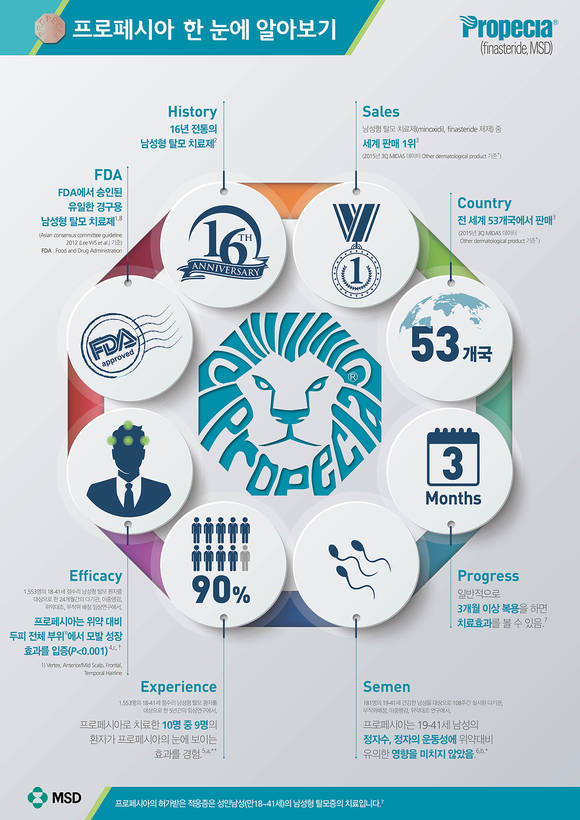
한국 MSD 남성형 탈모치료제 프로페시아®1 의 정보 및 임상 결과를 시각화하여 쉽게 소개
한 눈에 알아보는 의료진 대상 인포그래픽 리플렛

한국 MSD(대표이사 현동욱)는 경구용 남성형 탈모 치료제 프로페시아® (피나스테리드 1mg)1 의 의료진 대상 인포그래픽 리플렛을 새롭게 선보인다고 밝혔다.
이번 인포그래픽 리플렛은 남성형 탈모 치료를 위해 개발된 선택적 제 2형 5알파 환원효소 억제제인 프로페시아®,3-6를 의료진들에게 효과적으로 소개하기 위해 기획되었다.
특히 제품의 정보, 효과를 입증한 장기 임상 연구 결과들을 숫자나 단어를 중심으로 시각화하여 쉽게 소개했다는 점, 국내 출시 16주년을 맞아2 새롭게 디자인된 프로페시아®의 심볼 마크(Symbol Mark)가 공개됐다는 점에서 주목할 만하다. 모라이언(毛 Lion)이라는 이름의 심볼 마크는 프로페시아® 로고와 사자 갈기를 접목해 남성형 탈모 치료제의 이미지를 형상화했다.
프로페시아®는 18세~41세 남성의 남성형 탈모 치료제 (Minoxidil,Finasteride) 중 세계 매출 1위를 기록하고 있다7,*. 특히, 프로페시아®의 주성분인 피나스테리드는 국내 시판 경구용 남성형 탈모 치료제 중에서는 유일하게 미국식품의약국(FDA)과 국내 식품의약품안전처(MFDS)의 승인을 모두 받았다2,6,8.
5년 간 18세~41세 나이의 경도-중증도 정수리 부위의 남성형 탈모 환자 1,553명 대상 무작위, 이중맹검, 위약대조로 진행한 연구 결과, 프로페시아®로 치료한 10명 중 9명의 환자가 눈에 보이는 효과를 경험한 것으로 나타났다9,a,**. 단, 일반적으로 프로페시아®의 탈모 치료 효과는 3개월 이상 복용해야 효과를 볼 수 있다1.
또한, 19-41세 181명의 건강한 남성을 대상으로 다기관, 무작위, 이중맹검, 위약대조로 108주간 실시한 연구 결과, 프로페시아®는 정자수, 정자의 운동성에 위약과 비교해 유의한 영향을 미치지 않는 것으로 확인됐다10,b,***.
한국 MSD 프로페시아® 마케팅팀 이보아 과장은 “프로페시아가 경구용 남성형 탈모 치료제 시장을 이끄는 리딩 브랜드이자 세계 남성형 탈모 치료제(Minoxidil, Finasteride) 시장에서 매출 1위를 지켜온 것은 입증된 장기간의 효과, 정자 관련 연구, 다양한 남성형 탈모 치료 가이드라인9-13등에서 축적된 근거들이 뒷받침 되었기 때문이라 생각한다. 이러한 근거들이 있기에 새로운 형태의 인포그래픽 리플렛도 제작할 수 있었다”며, “앞으로도 의료진에게 대한민국 남성형 탈모 치료제 시장을 이끌어 온 프로페시아®의 축적된 임상 데이터와 정보를 새롭게 전달하기 위한 시도와 노력을 이어갈 것”이라고 말했다.
한편, 전 세계 53개국에서 판매7되고 있는 프로페시아®는 남성형 탈모의 주요 원인인 DHT(dihydrotestosterone)를 생성시키는 5알파 환원효소 중 제 2형 5알파 환원효소를 선택적으로 억제해 남성형 탈모를 호전9시키는 치료제다.
국내에는 2000년에 출시2되었으며, 국내에 시판되는 경구용 남성형 탈모 치료제 중 유일하게 미국 식품의약국(FDA)의 승인을 받았다6,8. 프로페시아®는 일본 및 유럽, 아시아 컨센서스 위원회 가이드라인에서 남성형 탈모 치료에 추천되는 치료제로 선정된 바 있다11-13.
FDA: Food and Drug Administration
MFDS: Ministry of Food and Drug Safety
* 2015년 3Q MIDAS 데이터 Other dermatological product 기준: 한국, 미국, 캐나다, 영국, 호주, 일본, 중국 등의 프로페시아Ⓡ를 현재 판매 중인 국가 53개국이 포함된 총 63개국을 바탕으로 함.7
**[Primary endpoint result]: In the group that received finasteride for up to five years(Fin → Fin), there were significant increases in hair counts over five years (p < 0.001 versus baseline for all time points).9
*** [Primary endpoint result]:Compared to placebo 1 mg. finasteride had no significant effect on sperm concentration, total sperm per ejaculate, sperm motility or morphology at any time. Median ejaculate volume at the end of the on-drug period decreased by 0.3 ml. (-10.9%, 95% CI - 18.9 to 4.3) in finasteride and by 0.2 ml. (-7.8%, 95% CI -25.5 to 3.9) in placebo groups, with a between treatment group difference of -0.03 ml. (1%, 90% CI -10.4 to 13.1, p = 0.915). There were significant but small decreases in prostate volume (-2.6%) and serum PSA (-0.2 ng./ml.) in the finasteride group, which reversed on discontinuation of the drug.10
a. This study initiated two initial, 1-year, randomized, double-blind, placebo controlled studies and both were continued as four consecutive, 1-year, doubleblind, placebo controlled extension studies. Men aged 18 to 41 years, with mild to moderately severe vertex MPHL according to a modified Norwood/Hamilton classification scale (Ⅱ vertex, Ⅲ vertex, Ⅳ or Ⅴ) were enrolled. In 1 year initial studies, 1553 men with MPHL received Finasteride 1mg/day or placebo for one year and in four consecutive 1 year extension studies, 1215 men received either Finasteride 1mg or placebo. The efficacy was evaluated by hair counts, patients and investigator assessments, and panel review of clinical photographs.9
b. Double-blind, placebo controlled multicenter study 181 men 19 to 41 years were randomized to receive 1mg. finasteride or placebo for 48 weeks followed by a 60-week off-drug period. Of the 181 men 79 were included in subset for the collection and analysis of sequential semen samples. The objective is to study the potential effect and reversibility of effect of 1mg finasteride daily on spermatogenesis, semen production, the prostate and serum prostate specific antigen in young men.10
References
1 Propecia prescribing information. MSD Korea.
2 식약처. 전자민원창구 의약품. 정보마당. 처방정보(프로페시아). Available at <http://ezdrug.mfds.go.kr/kfda2> Accessed 07 Jan 2016.
3 Roberts JL, et al. Clinical dose ranging studies with finasteride, a type 2 5alpha-reductase inhibitor, in men with male pattern hair loss. J Am Acad Dermatol 1999;41:555-63.
4 Kaufman et al. Finasteride in the treatment of men with androgenetic alopecia. J Am Acad Dermatol 1998;39:578-89;
5 Leyden et al. Finasteride in the treatment of men with frontal male pattern hair loss. J Am Acad Dermatol 1999;40:930-937
6 FDA. Drugs@FDA. PROPECIA. Available at <http://www.accessdata.fda.gov/scripts/cder/drugsatfda/index.cfm?fuseaction=Search.DrugDetails> Accessed 07 Jan 2016.
7 MIDAS Health Data, with finasteride and minoxidil drugs of Androgenic alopecia in the world (63 countries incl. USA), Sales Value(USD), 2015 Q3 data. (Data on file).
8 Lee WS, et al. Guidelines for management of androgenetic alopecia based on BASP classication--the Asian Consensus Committee guideline. J Eur Acad Dermatol Venereol. 2013;27:1026-1034.
9 Kaufman KD et al. Long-term (5-year) multinational experience with finasteride 1 mg in the treatment of men with androgenetic alopecia. Eur J Dermatol. 2002;12:38-49
10 Overstreet JW, Fuh VL, Gould J, et al. Chronic treatment with finasteride daily does not affect spermatogenesis or semen production in young men. J Urol. 1999 Oct;162(4):1295-1300.
11 Lee WS et al. Guidelines for management of androgenetic alopecia based on BASP classification-the Asian consensus committee guideline. JDADV. 5 June 2012 [Epub ahead of print]. Available at <http://onlinelibrary.wiley.com/doi/10.1111/jdv.12034/pdf> Accessed 20 May 2013.
12 Tsuboi R et al. Guidelines for the management of androgenetic alopecia (2010). Journal of Derm. 2011;38:1-8
13 Blumeyer A et al. Evidence based (S3) guidelines for the treatment of androgenetic alopecia in women and in men. 2011. J dtsch Dermatol Ges. 2011;6:S1-57.
